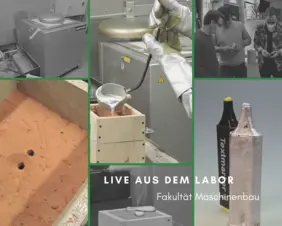The Laboratory for Welding and Cutting Technology of the Faculty of Mechanical Engineering and the Faculty of Industrial Engineering and Management has a new ladling furnace for the foundry. This is an essential component for practical training, for final and scientific theses and, in the future, also for research projects. The focus is on the topics of sand and gravity die casting with the solidification behaviour of melts and emerging casting defects.
The first experiment with the new ladle furnace: casting a highlighter in sand casting
Learning by example was the aim of the first experiment in which students of the 1st and 2nd semester of the Master's programme in Materials Engineering in Mechanical Engineering were active in the laboratory. The aim was to get to know aluminium mould casting, in particular the production of a sand mould, and to experience and reflect on the reaction of the melt, its properties, solidification and possible resulting casting defects.
The first step was to choose a model and prepare it for hand moulding. In our example, this was a highlighter. This was followed by the creation of a mould from oil-bonded sand before the aluminium ingots melted at 750°C in the electrically heated ladling furnace with a melting volume of 20 kilograms. A manual pouring with a ladle filled the moulds with the molten aluminium and it was possible to observe whether the melt found its way.
After solidification, the cast of the highlighter could be demoulded and reworked for casting analysis. The results were shown in a presentation and the course of the experiment with the different results was discussed together, as well as solutions for problems that had occurred were worked out.
In practice, sand casting is the most frequently used casting process in the production of prototypes or in series production. In car manufacturing, for example, it is used in the series production of chassis parts such as the trapezoidal control arm. Possible innovative occupational fields in this field are thus process and material development, component development or quality assurance and failure analysis of cast components.
Materials technology in mechanical engineering:
As part of mechanical engineering, materials technology is closely linked to the disciplines of "manufacturing processes" and "design". This is because the selection of materials, the correct manufacturing process and the design must be considered in an interlocking manner, as together they ultimately determine the properties of a component.
In short, to create a complex and near-net-shape cast component, the material used must be easy to cast. This includes the mould filling capacity, the flow properties and the feeding capacity. And in the end, clearly defined properties - such as strength, ductility, pressure density, corrosion resistance or weldability - must be met. The selection and optimisation of a material is thus an important and fundamental building block for high-performance, efficient and sustainable components.
The Welding and Cutting Technology Laboratory:
In the laboratory for welding and cutting technology, students are trained in the basics of welding technology (all common welding processes) and foundry science (sand casting, gravity die casting). Here they can put the theoretical knowledge in the field of casting and welding into practice, have the possibility of material separation through a plasma cutting machine and can also microscopically prepare and examine the sample material in the materials technology laboratory.


![[Translate to English:] Gießofen im Labor](/fileadmin/_processed_/0/6/csm_Schoepfofen_klein_46da220873.webp)
![[Translate to English:] Selbstgebaute Sandform](/fileadmin/_processed_/c/4/csm_Sandform_klein_cc12dd72a3.webp)
![[Translate to English:] Guss des flüssigen Aluminiums](/fileadmin/_processed_/0/f/csm_Aluminiumformguss_klein_4afa93a6c3.webp)
![[Translate to English:] Sandform mit heißem Aluminium](/fileadmin/_processed_/7/0/csm_gefuellte_Form_klein_6369671901.webp)
![[Translate to English:] Abguss des Textmarkers](/fileadmin/_processed_/9/e/csm_Abguss_Textmarker_klein_51362a5f6d.webp)
![[Translate to English:] Begutachtung des Ergebnisses](/fileadmin/_processed_/3/2/csm_Studierende_Ergebnis_klein_3107f1ea23.webp)
![[Translate to English:] Textmarker aus Aluminium](/fileadmin/_processed_/b/b/csm_Textmarker_zweifach_klein_41cb7b0348.webp)
![[Translate to English:] Logo Akkreditierungsrat: Systemakkreditiert](/fileadmin/_processed_/2/8/csm_AR-Siegel_Systemakkreditierung_bc4ea3377d.webp)








![[Translate to English:] Logo IHK Ausbildungsbetrieb 2023](/fileadmin/_processed_/6/0/csm_IHK_Ausbildungsbetrieb_digital_2023_6850f47537.webp)


